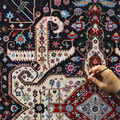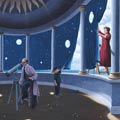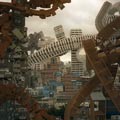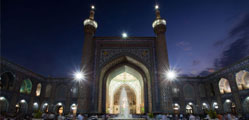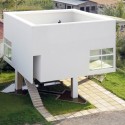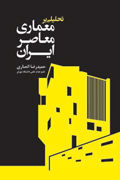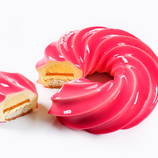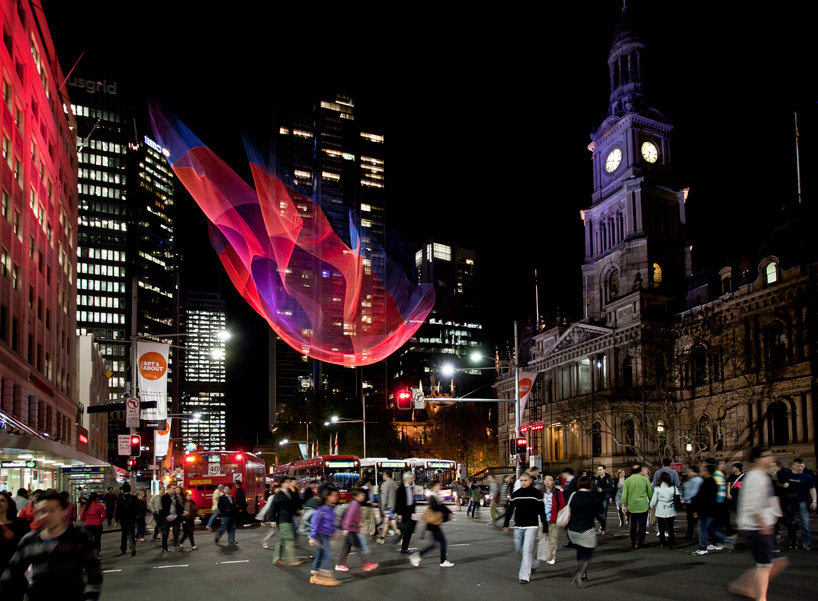
image courtesy of janet echelman
Continue after the break to view some of Echelman’s most famous projects.
She Changes, 2005 – Porto, Portugal Using color and material to invoke the memory of the site’s history as a fishing and industrial center, this three-dimensional multi-layer net floats over the Cidade Salvador Plaza. This work is credited as the first permanent, monumental public sculpture to use an entirely soft and flexible set of membranes moving fluidly in wind. The work casts cinematic shadow drawings onto the ground further highlighting the “wind choreography.” The the city has made the sculpture its graphic symbol. When interviewed, local people give different interpretations of the work, from fishing nets, ships and masts of the Portuguese maritime history, the red-and-white striped smokestacks of the area’s industrial past, to Portuguese lace, sea creatures and ripples in water.
Three steel poles, ranging in height from 25 to 50 meters, are painted white with red stripes to reference nearby smokestacks and lighthouses. These poles support a 20 ton steel ring, 45 meters in diameter, from which the net weighing about one ton is suspended. The ring greets the ocean at a slant, ranging from 13.5 meters off of the ground at the lowest point and 27 meters at the highest. The smokestack reference is continued through the red and white stripes of the net.
The net is comprised of 36 individual mesh sections in different densities, hand-joined along all sides into a multi-layered form. The net material is TENARA® architectural fiber, a 100% UV-resistant, colorfast fiber made of PTFE (poly-tetra-fluoro-ethylene), the substance most widely known as the non-stick cooking surface Teflon®.
Her Secret Is Patience, 2009 – Phoenix, AZ This project makes visible to the human eye the patterns of desert winds. During the day, sunlight projects patterned shadow drawings onto the ground and pedestrians on their daily paths. At night, the colored illumination gradually changes color through the seasons. The large three-dimensional multi-layered form is created by a combination of hand and machine knotting of recyclable high-tenacity colored polyester that is replaced in new color variations at intervals.
The sculpture is comprised of painted galvanized steel and cables, changing sets of recyclable high-tenacity polyester braided twine netting and colored lighting with computerized programming.
Tsunami 1.26, 2011 – Sydney, Australia Tsunami 1.26, an aerial lace installation, was inspired by the 2010 Chile earthquake’s ensuing tsunami and the 1.26-microsecond shortening of the day that resulted from the earthquake’s redistribution of the Earth’s mass. By meditating on these epiphenomena, the work underscores the interdependence of Earth systems and the global community. It asks the viewer to pause and consider the larger fabric of which they are a part.
Studio Echelman generated a 3D model of the tsunami using data from NASA’s Jet Propulsion Laboratory and the NOAA Center for Tsunami Research and then used software to transform an outline of the model’s higher amplitude area into a sculptural form. Additionally, the studio created hand-knotted models to achieve the complex shaping of the piece.
This artwork utilizes Spectra®, a material 15 times stronger than steel by weight. The mesh is knotted by machine in order to withstand winds, but is engineered to reflect the intricacy of handmade lace.
1.26, 2010 – Denver, CO 1.26 Sculpture Project at the Biennial of the Americas
July 6-August 6, 2010
Illumination hours: 9pm-6am
Janet Echelman’s 230-foot-long aerial sculpture “1.26” suspends from the roof of the 7-story Denver Art Museum above downtown street traffic to commemorate the inaugural Biennial of the Americas.
The City of Denver asked the artist to create a monumental yet temporary work exploring the theme of the interconnectedness of the 35 nations that make up the Western Hemisphere. She drew inspiration from the NASA Jet Propulsion Laboratory’s announcement that the February 2010 Chile earthquake shortened the length of the earth’s day by 1.26 microseconds by slightly redistributing the earth’s mass. Exploring further, Echelman drew on a National Oceanic and Atmospheric Administration (NOAA) simulation of the earthquake’s ensuing tsunami, using the 3-dimensional form of the tsunami’s amplitude rippling across the Pacific as the basis for her sculptural form.
The temporary nature of the Biennial and its accelerated timeline precluded the artist’s use of a permanent steel armature, as employed in the artist’s previous monumental permanent commissions. Instead, “1.26” pioneers a tensile support matrix of Spectra® fiber, a material 15 times stronger than steel by weight. This low-impact, super-lightweight design made it possible to temporarily attach the sculpture directly to the façade of the Denver Art Museum, and this structural system opens up a new trajectory for the artist’s work in urban airspace.
Because this monumental sculpture is made entirely of soft materials, it is animated by the wind. Its fluidly moving form contrasts with the rigid surfaces of the surrounding urban architecture. At night, colored lighting transforms the work into a floating, luminous form while darkness conceals the support cables.
A book about “1.26” includes an essay by Sanford Kwinter, Professor of Architectural Theory and Criticism at the Harvard Graduate School of Design, cofounder of the journal Zone and Zone Books, and author of Architectures of Time: Towards a Theory of the Event in Modernist Culture.
Water Sky Garden, 2009 – Richmond, British Columbia Water Sky Garden transforms the plaza surrounding the Richmond Olympic Oval, official venue for the 2010 Vancouver Olympic Winter Games speed-skating events, into a permanent art environment for the community. Echelman’s design engages the space all around the viewer – water, sky, and pedestrian pathways – to create an immersive whole using rock, wood, water, air bubble fountains, steel, netting, and light.
Red-stained cedar boardwalks lead visitors through the artwork. Water purifying aerators draw shapes with bubbles on the surface of a pond that collects runoff water from the Ovals’ 5-acre roof, while suspended net-forms undulate overhead in the wind, becoming sky-lanterns during nighttime illumination.
The red boardwalk and “sky lanterns” are inspired by the city’s cultural communities. Richmond has the largest immigrant population by proportion of any city in Canada with the majority of those immigrants being of Asian descent. The wooden boardwalk follows a curving path similar to the choreography of the Dragon Dance, a performance frequently seen in local Chinese festivals. The Nitobe Japanese garden and the Sun Yat Sen Chinese garden of the Vancouver region are important references, especially their material presence, intersecting paths and reflective ponds, and their framing of views. Water Sky Garden is a contemplative art environment that encourages participants to linger. The overhead netted forms provide a new visual experience, putting art in the sky; at night they glow like lanterns. Nets have a special relationship with the site, as the native Musqueam Band continue to teach their children to fish using nets at this particular bend in the Fraser River to this day, and this area has a history of the fishing/canning industry which employed many ethnic groups.
This project was achieved through Echelman’s collaboration with a team of international award-winning architects, engineers, lighting and water consultants, landscape architects and fabricators.
Every Beating Second, 2011 – San Francisco, CA Artist Janet Echelman transforms the terminal with fictional nature that subtly engages viewers with real and imagined natural forces. Her sculpture installation cuts three round skylights into the ceiling, from which descend delicate layers of translucent colored netting to create three voluptuous volumetric forms. A series of shaded outlines below are embedded into the terrazzo floor, reflecting the precise shadows that would occur on the summer solstice if the sun could penetrate through the roof. During the day, sun streams through the skylights to cast real shadows that interplay with the fictional shadows in the floor. At night, the artist’s program of colored lighting makes the sculpture glow from indigo to purple, magenta to red-orange. Computer-programmed mechanized air-flow animates the fluidly-moving sculpture at different intervals throughout the day, as if the wind could magically flow through solid walls.
The artist achieved the sculpture’s physical presence by braiding fibers and knotting twine into sculptural netting suspended from powder-coated steel armatures. Despite their large scale, more than 120 feet in circumference for a single form, her sculpture is experienced as ephemeral and weightless. Visually, the sculpture evokes the contours and colors of cloud formations over the Bay and hints at the silhouette of the Golden Gate Bridge. Aesthetically, the sculpture looks both backwards and forwards, drawing its color from the heyday of psychedelic music, the Summer of Love, and San Francisco’s prominence in the beat poetry movement, while also referencing the contemporary bay area as a hub of innovation and interconnectivity for the world of technology.
The title, Every Beating Second, referring to a line by beat poet Allen Ginsberg, represents the artist’s interest in heightening awareness of the present moment:
live
in the physical world
moment to moment
I must put down
every recurring thought—
stop every beating second (11-16)
All project descriptions provided by Studio Echelman.

















---
earlier this year design 360° magazine spoke to american artist janet echelman. here she explains her work process in detail and how the different countries she has lived in have shaped her approach.
360°: what drew you to working with fish nets?
JE:it’s natural aesthetic capability to assume complex curvilinear forms, in terms of structural engineering, while also offering a distributed network where even if one point is not able to carry its load, the others still continue to function.
after graduating from college, I went to the university of hong kong on a scholarship to study chinese calligraphy and visual art. this was great training for me, as I learned the importance of honing a traditional skill to create an expressive work of art. they say it takes 40 years of practice to make a calligraphic stroke in 4 seconds, and I now understand what that means.
I spent the first decade of my career studying craft forms in asia, after hong kong I moved to the island of bali, indonesia, there I studied batik and other textile crafts while I had a grass-roofed studio and home on the rice fields in view of the volcanoes. ten years later, I discovered sculpting when I went off to india on a fulbright.I was there to teach painting with a commitment to create large paintings, but my paints never arrived.so I decided to embrace what was there. every evening after working in the studio, I would walk on the beach and swim, just as the fishermen were bringing in their nets. it occurred to me that their nets were creating form without mass in a completely unique way. once I made some forms from the nets, I hoisted them into the air and discovered that they billowed softly and made the unseen dance of wind visible.my strategy is to let my work be choreographed by nature. then it is ever changing, renewed at every moment. I want people to relate to my work not as an observer to a discrete object, but rather as a relationship between two entities that are both changing at all times,which is what is revealed through this material.
for my newest commission I have expanded beyond the net-making technique. I’m using a completely new material: water mist combined with colored light, to transform the center of philadelphia.
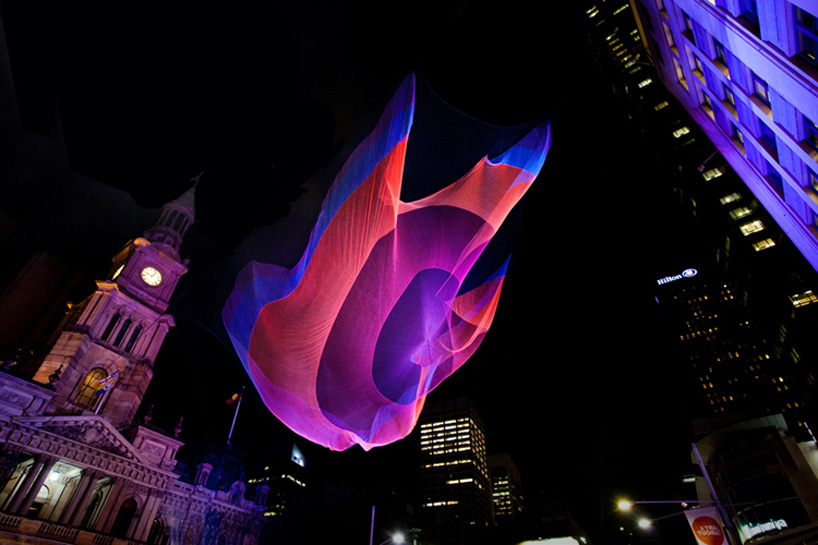
'tsunami' sydney, 2011
tsunami 1.26, an aerial lace installation, was inspired by the 2010 chile earthquake’s ensuing tsunami and the 1.26-microsecond shortening of the day that resulted from the earthquake’s redistribution of the earth’s mass.
image courtesy of janet echelman
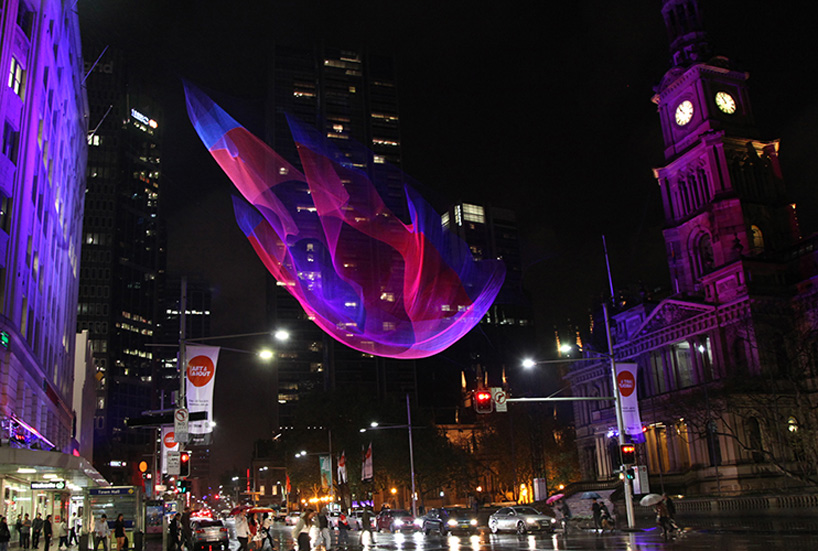
'tsunami' sydney, 2011
image courtesy of janet echelman
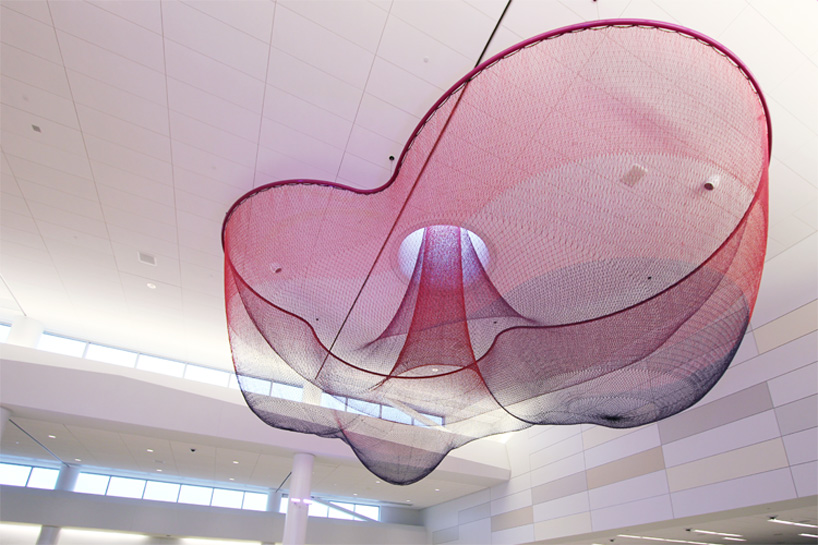
'every beating second', san francisco, 2011
artist janet echelman transforms the terminal with fictional nature that subtly engages viewers with real and imagined natural forces. her sculpture installation cuts three round skylights into the ceiling, from which descend delicate layers of translucent colored netting to create three voluptuous volumetric forms.
image courtesy of janet echelman
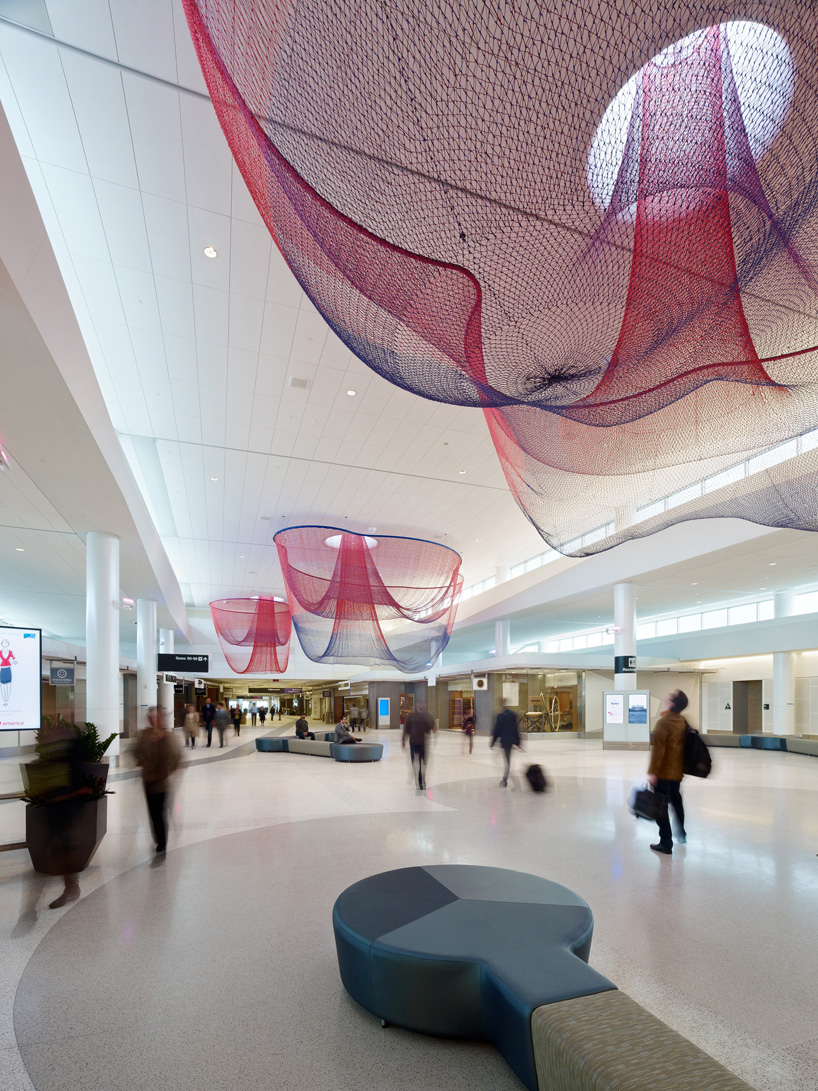
'every beating second', san francisco, 2011
image courtesy of janet echelman
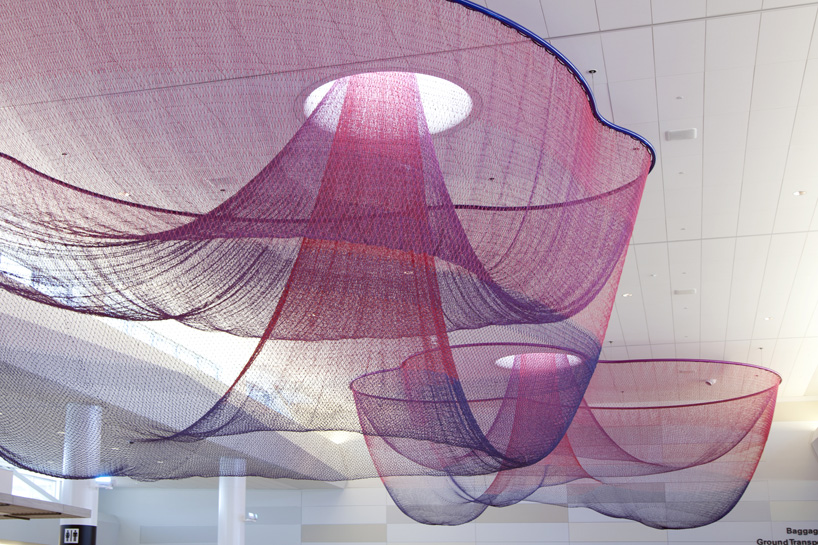
'every beating second', san francisco, 2011
image courtesy of janet echelman
most of your installation works are in large scale, were they handmade or machine-made? what do you feel are the pros and cons of machine-making? when I began making these netted works, they were fabricated 100% by hand, made possible by my work with a group of 9 fishermen in south india. in fact, after my fulbright I spent some time in lithuania studying traditional lace making techniques there, and my permanent commission for their museum is also 100% hand-made.
all of my more recent works are a combination of machine and hand work. we utilize the machines for what they do best: making rectilinear panels with strong machine-tightened knots that can withstand a hurricane. we use hand-work specifically to create unusual irregular shapes and joints, and to make lace patterns.
are there any major difference between your outdoor and indoor installation works? the outdoor work is animated by nature, the ever-changing movement of wind enlivens the work into a living sculpture. I work with the movement of the sun throughout the day to create varied shadow patterns cast upon the ground, and upon people, who thereby
become participants in the work.
the interior work is focused on the play of the soft forms in contrast to the architecture. in recent work i have cut curved holes in the ceiling and roof to create skylights as part of my interior work, thus joining exterior and interior. I love the challenge of both types of projects.
the softness and delicacy of your net installations make us think of a feminine image. can we see it as a kind of feminine element in your work? I leave the interpretation of my work open to each individual, to create their own meaning. some viewers have given a feminist reading of the work, referring to the soft and fluid ways the work gains its strength through an ability to adapt, rather than by brute force. for me, personally, I do not think of this quality as either feminine or masculine, but as a human quality.
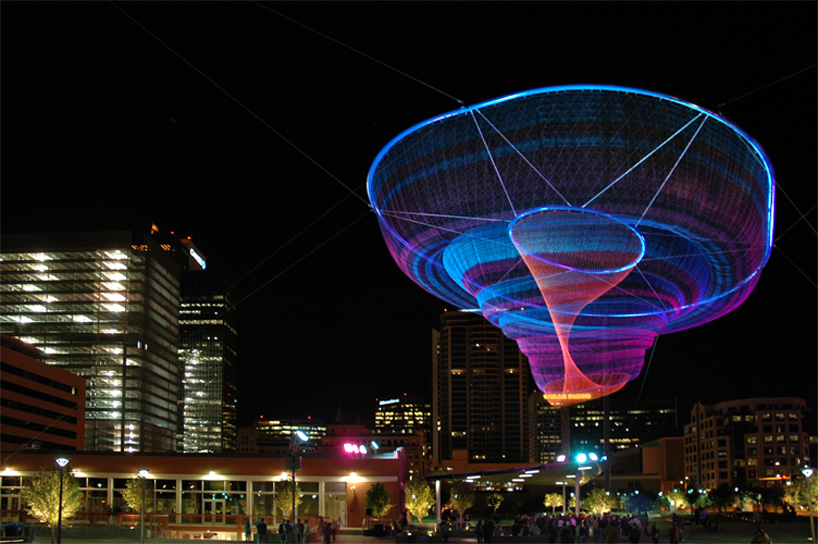
'her secret is patience', phoenix, 2009
this project makes visible to the human eye the patterns of desert winds. during the day, sunlight projects patterned shadow drawings onto the ground and pedestrians on their daily paths. at night, the colored illumination gradually changes color through the seasons. the large three-dimensional multi-layered form is created by a combination of hand and machine knotting of recyclable high-tenacity colored polyester that is replaced in new color variations at intervals.
image courtesy of janet echelman
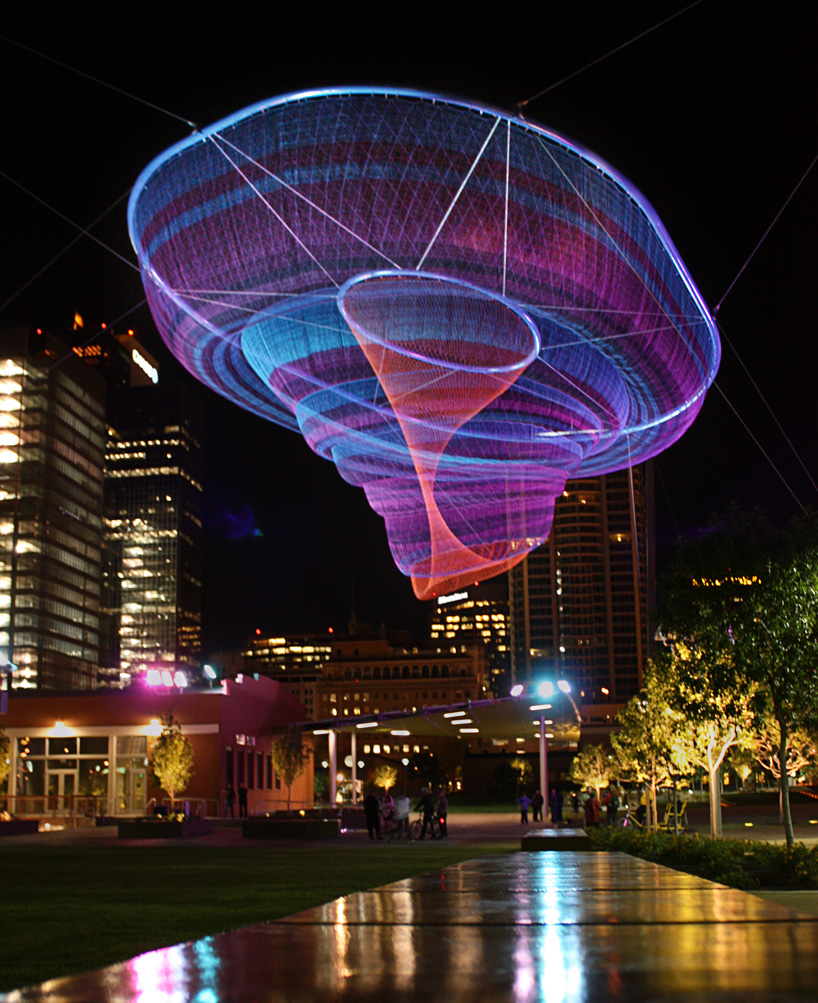
'her secret is patience', phoenix, 2009
image courtesy of janet echelman
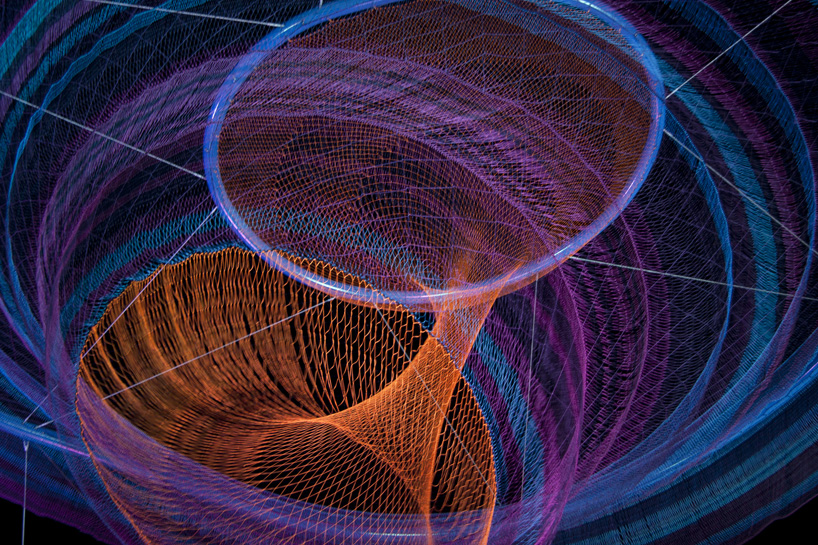
'her secret is patience', phoenix, 2009
image courtesy of janet echelman
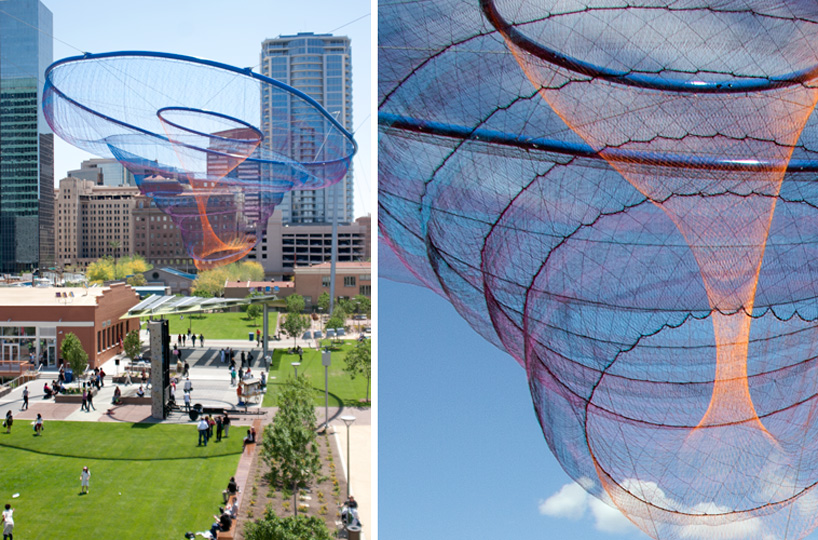
'her secret is patience', phoenix, 2009
image courtesy of janet echelman
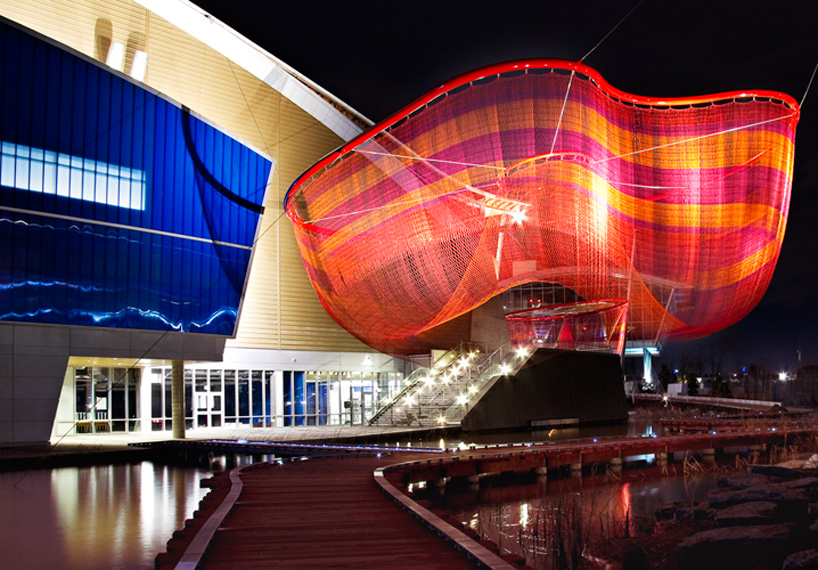
'water sky garden', richmond, 2009
water sky garden transformed the plaza surrounding the richmond olympic oval, official venue for the 2010 vancouver olympic winter games speed-skating events, into a permanent art environment for the community. image courtesy of janet echelman
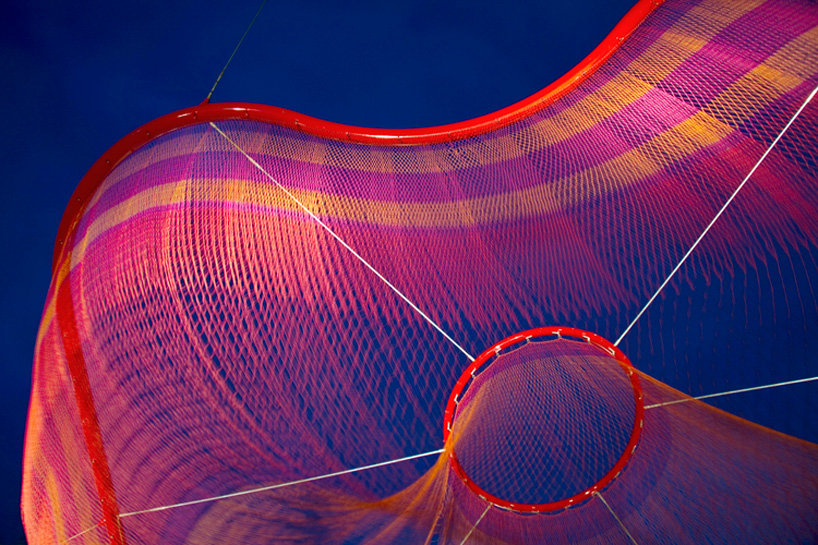
'water sky garden', richmond, 2009
image courtesy of janet echelman
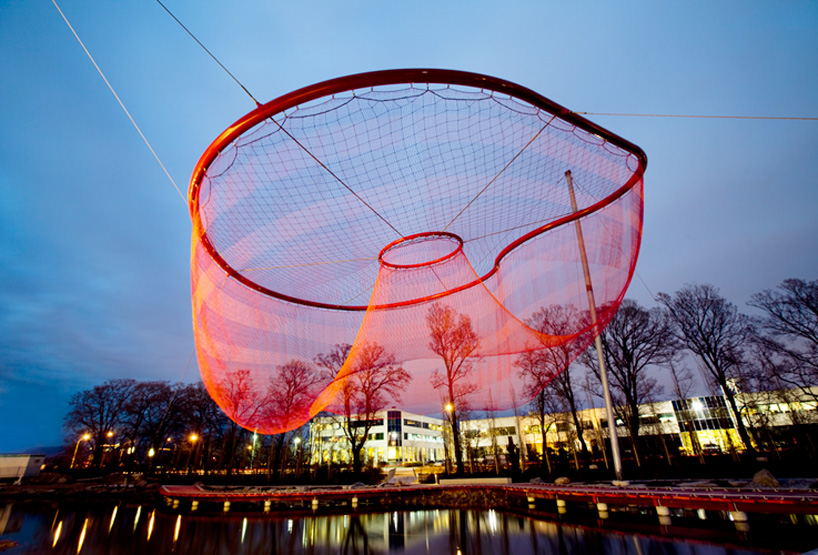
'water sky garden', richmond, 2011
image courtesy of janet echelman
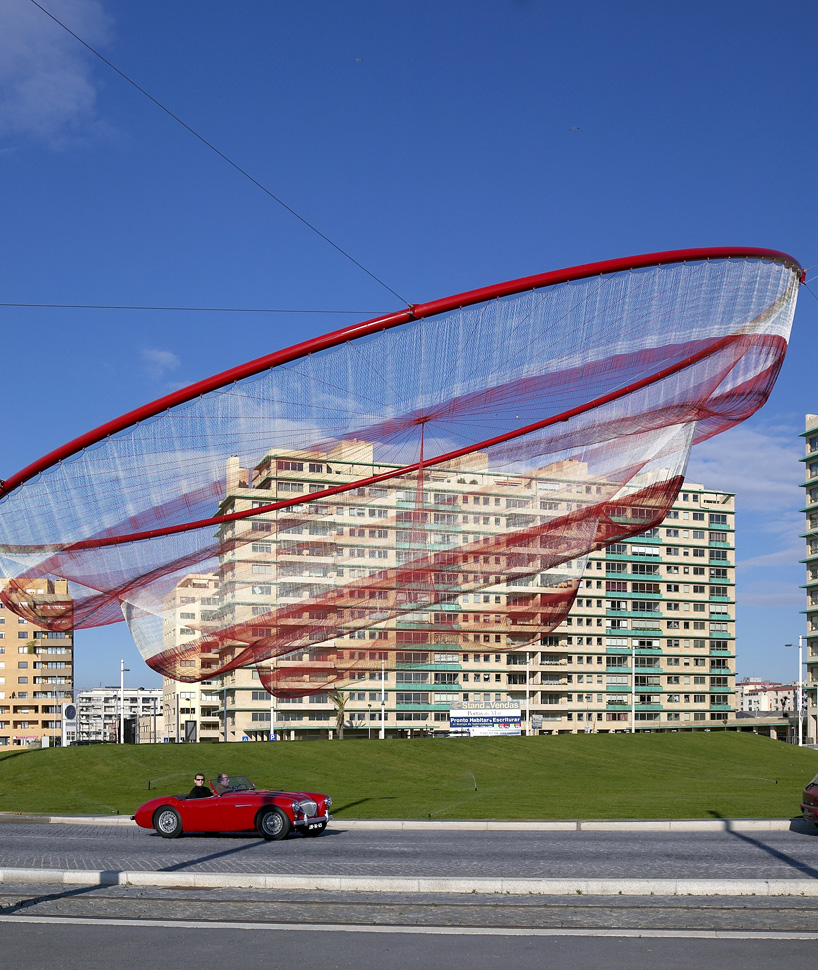
'she changes' porto, 2005
using color and material to invoke the memory of the site’s history as a fishing and industrial center, this three-dimensional multi-layer net floats over the cidade salvador plaza. this work is credited as the first permanent,
monumental public sculpture to use an entirely soft and flexible set of membranes moving fluidly in wind.
image courtesy of janet echelman
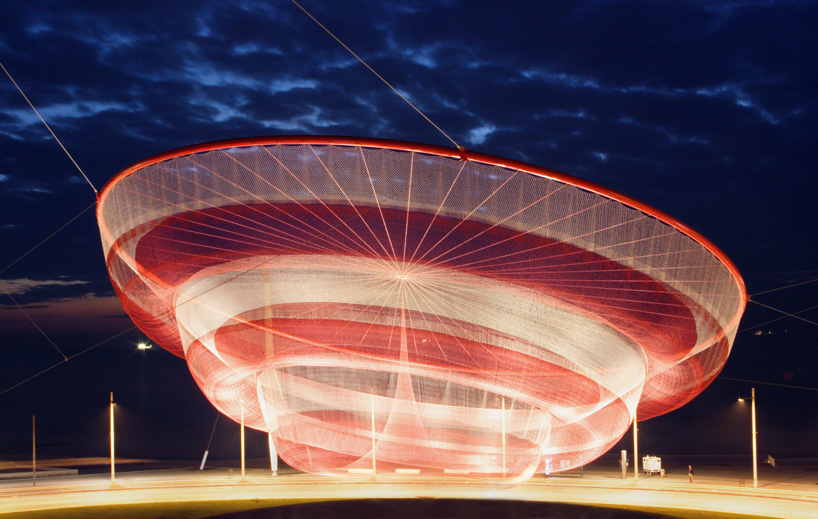
'she changes' porto, 2005
image courtesy of janet echelman
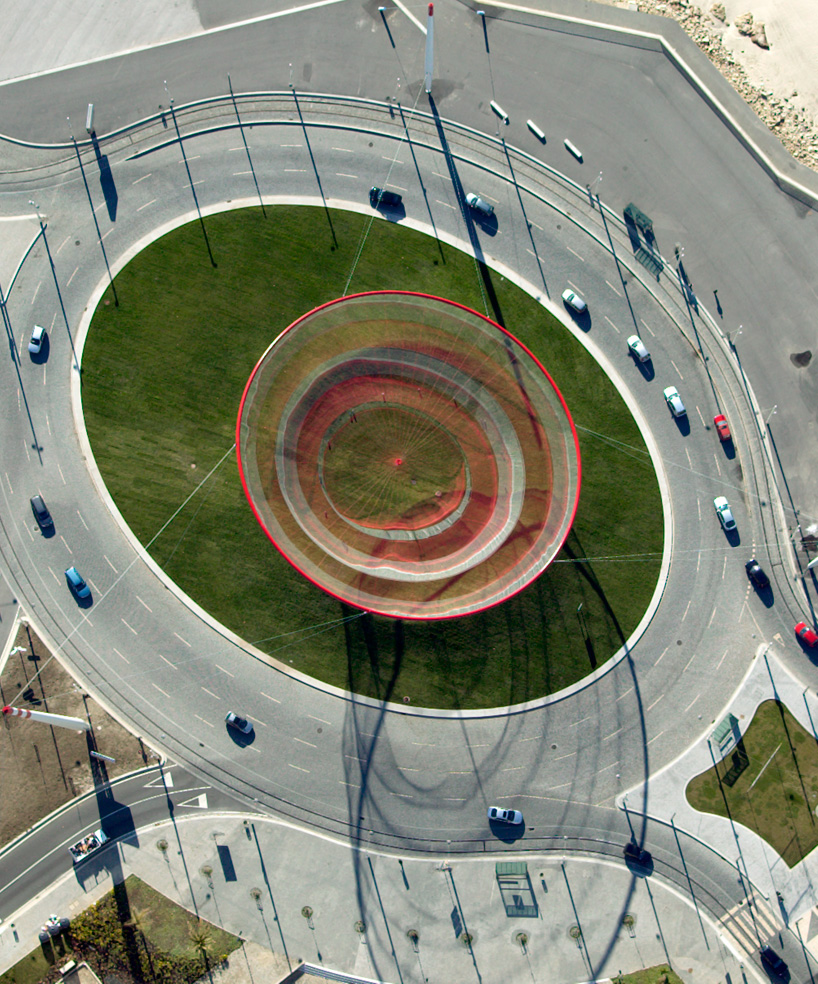
'she changes' porto, 2005
image courtesy of janet echelman
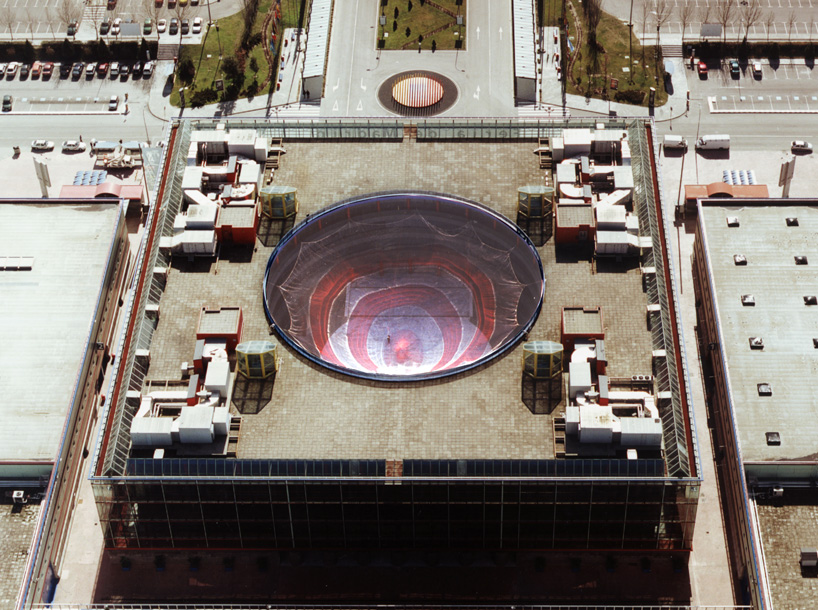
'target swooping down... bullseye!', madrid, 2001
image courtesy of janet echelman
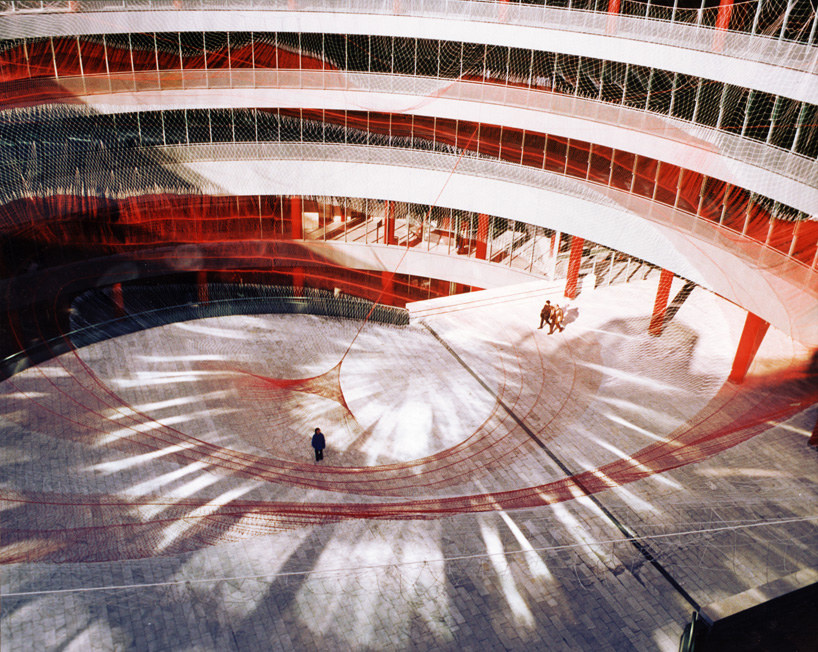
'target swooping down... bullseye!', madrid, 2001
image courtesy of janet echelman
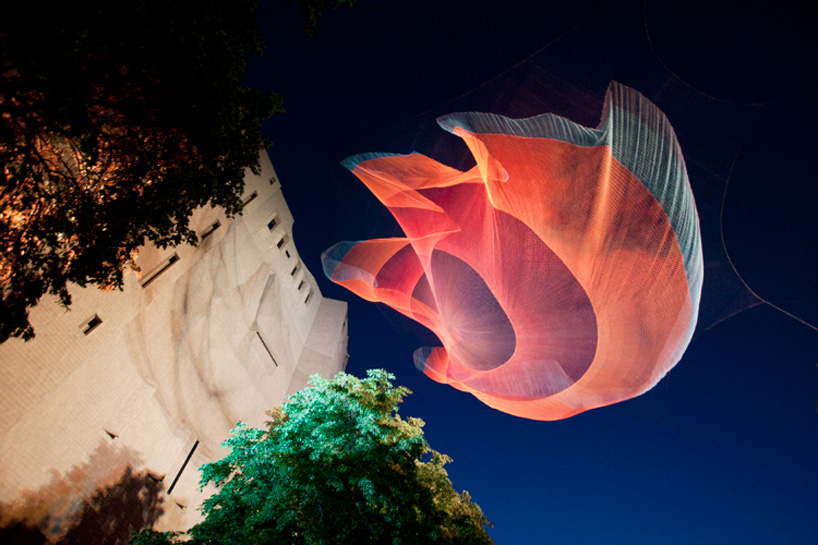
'1.26', denver, 2011
the city of denver asked the artist to create a monumental yet temporary work exploring the theme of the interconnectedness of the 35 nations that make up the western hemisphere. she drew inspiration from the nasa jet propulsion laboratory’s announcement that the february 2010 chile earthquake shortened the length of the earth’s day by 1.26 microseconds by slightly redistributing the earth’s mass.
image courtesy of janet echelman
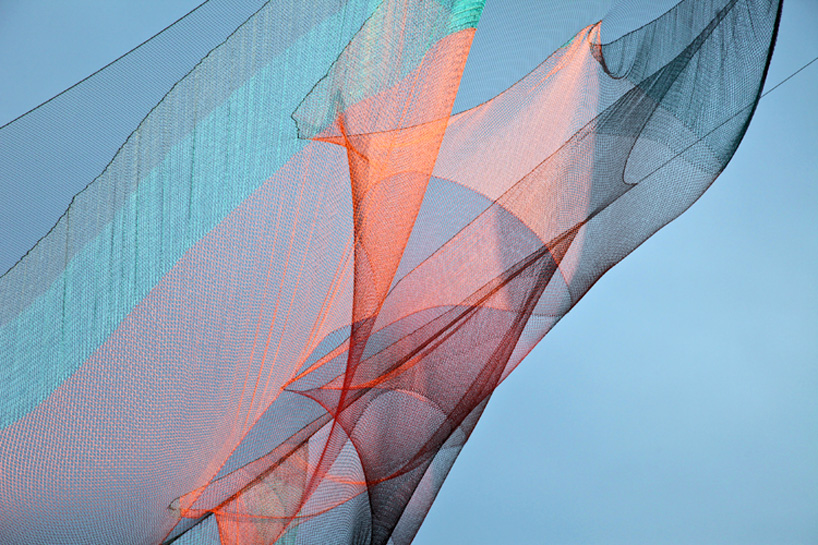
'1.26' detail
image courtesy of janet echelman
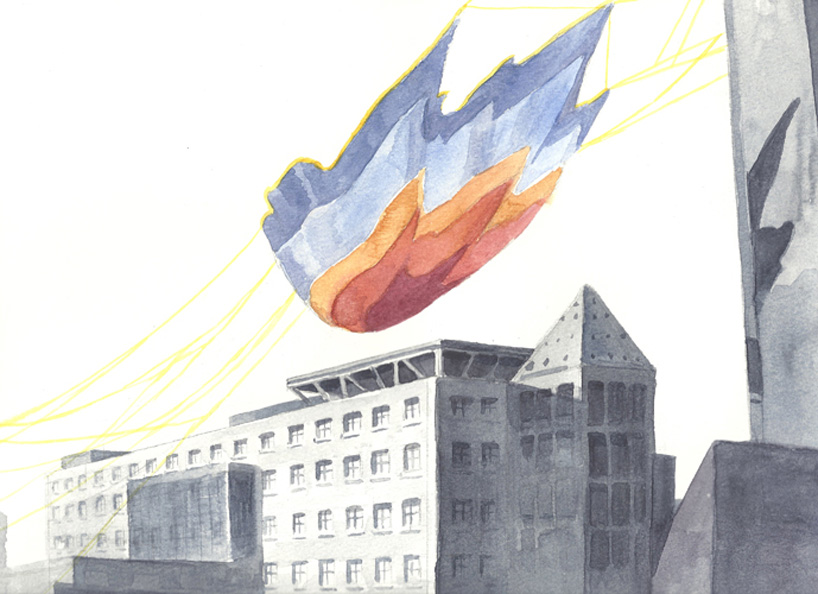
'1.26' watercolor
image courtesy of janet echelman
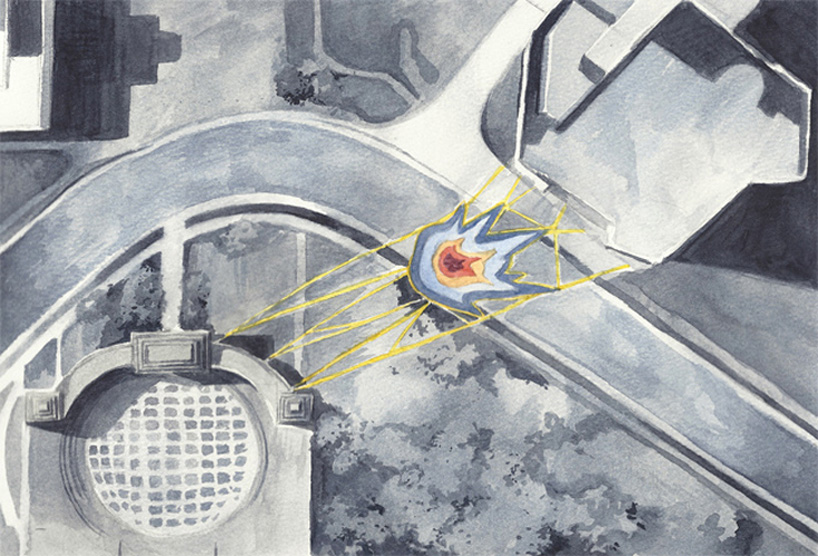
'1.26' watercolor
image courtesy of janet echelman




